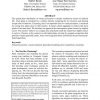Free Online Productivity Tools
i2Speak
i2Symbol
i2OCR
iTex2Img
iWeb2Print
iWeb2Shot
i2Type
iPdf2Split
iPdf2Merge
i2Bopomofo
i2Arabic
i2Style
i2Image
i2PDF
iLatex2Rtf
Sci2ools
WSCG
2004
2004
Clustering in Virtual Plant Ecosystems
The spatial plant distribution in virtual ecosystems is usually modeled by means of artificial life. Each plant is considered as a solitary element competing for its resources and obeying simple rules of behavior. Clustering, that is an important clue for visual perception, is achieved by sowing new plants close to their parents. In nature, plants aggregate to clusters that favor plants of the same kind. We introduce an approach that encompasses plant clusters by implicit curves. The clusters "behave" as compact units and plants inside the cluster have higher chance to survive. Clusters, in the contrary to individual plants, develop by grouped competition that provides visually plausible results, more convincing than those achieved by the previously published algorithms Keywords Virtual ecosystems, visual simulation, procedural modeling, plant competition, clustering
| Added | 31 Oct 2010 |
| Updated | 31 Oct 2010 |
| Type | Conference |
| Year | 2004 |
| Where | WSCG |
| Authors | Bedrich Benes, J. M. Soto Guerrero |
Comments (0)

